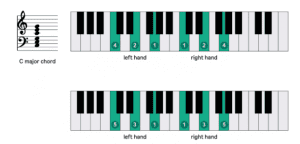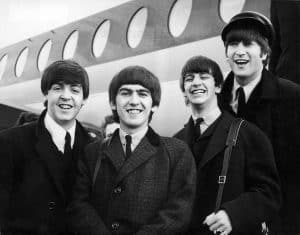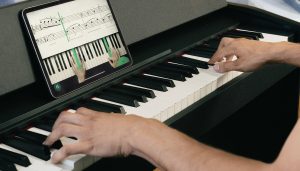The song ‘Happy Birthday’ was written in 1893 by Patty and Mildred Hill – two sisters who were school teachers. The tune was originally called ‘Good Morning To All’ and it was written for the school students to sing every morning to start their day.
Mildred Hill, who wrote the music, was born in Louisville, Kentucky, in 1859 and her younger sister Patty, who wrote the lyrics, was born in Anchorage, Kentucky, in 1868. Both sisters were inducted into the Songwriters’ Hall of Fame in 1996.
‘Happy Birthday’ is in the Guinness Book of World Records for being the most-sung song in the world. Learning how to play ‘Happy Birthday’ on the piano is one of the most useful things you can do – it will only be a matter of time before someone asks you to play it!
Our easy-to-follow Happy Birthday piano tutorial will teach you all the Happy Birthday piano notes and chords. In no time you’ll be able to accompany all those family birthday celebrations!
Let’s get started…
Cheat sheet
| Artist | Patty and Mildred Hill |
| Composer | Patty and Mildred Hill |
| Release year | 1893 |
| Genre | Traditional |
| Difficulty level | Beginner |
| Instrument | Piano / voice |
| Key | C major |
| Meter | 3/4 |
| Techniques | Hands together with single bass notes |
This tutorial provides a step-by-step guide to learning this famous and well-loved song. We’ll take you through the technical side of things, including which piano notes to play and when as well as the chords used to accompany the song. We’ll also provide background into the theoretical and stylistic aspects of the Happy Birthday song.
The lesson is geared towards beginner pianists looking for an easy way to play ‘Happy Birthday’ on piano. But even if you’re a more advanced player, there’s nothing to stop you from learning the song and perhaps even trying to sing and play the melody at the same time, or even adding some more complicated Happy Birthday piano chords!
“Happy Birthday” chords and progressions
In this tutorial we’ll introduce you to the ‘Happy Birthday’ chords on the piano. There is no song more instantly recognizable in the Western world; the song is played at celebrations worldwide. So you’re bound to hear it multiple times every year! Learning the Happy Birthday song on piano now will mean you can play it as and when required at celebrations with friends and/or family.
You’ll need to learn three chords to play the Happy Birthday sheet music: C major, G major, and F major. These are very useful to know as a pianist, not just when learning Happy Birthday on piano but because they are part of a very common chord progression found in thousands of other songs.
The fingerings for the C major chord are relatively straightforward – depending on the size of your fingers you may choose one of the following fingerings:

As you can see, the fingerings of each hand mirror the other, making it easy to memorize. Try them out and see which one fits your hands better!
The other chords in the song all follow the same finger pattern, just using different notes. Once you’ve learned the finger pattern you should be able to easily apply it to the other Happy Birthday chords as long as you know the starting note. The G major chord begins on G, and the F major chord begins on F. All of the chords in Happy Birthday use only white notes.
Below are diagrams of the other chords from Happy Birthday:
 G major chord
G major chord
 F major chord
F major chord
- Fall in love with the music - Learn your favorite songs, at a level suitable for you.
- Enjoy interactive piano lessons - Explore courses covering music theory, technique chords & more.
- Get real-time feedback - Skoove's feedback tells you what went well and what needs practice.

“Happy Birthday” lesson plan
Happy Birthday is so well-known that it’s something you basically have to know when learning how to play the piano, and this online piano lesson gives you everything you need to get started with learning how to play it!
Step 1: Listen to the song
It’s always a good idea to listen to the song in full so that you gain a good idea of what you’re working towards.
Step 2: Practice the Happy Birthday piano chords
Using the diagrams above to help you find the correct hand position, have a go at practicing the chords for Happy Birthday. Try each piano chord using separate hands to begin with and then see if you can play them with both hands together.
Step 3: Try the tune in the right hand only first
First slowly figure out the happy birthday music notes. Don’t worry too much about keeping in time to begin with. Make sure you get the correct starting position, with your right-hand thumb on the G above middle C.

Right-hand starting position: your thumb should be on G above middle C
Watch out for the octave jump from low G to high G in the middle of the tune. Here you’ll need to move your little finger onto the top G. Be sure to make this jump smoothly.

Right-hand position shift: move the little finger of the right hand onto a top G
When you’re descending from the top G you’ll play the notes G – E – C – B (which incidentally form part of a piano arpeggio). To play the B, you’ll need to tuck your index finger over the top of the thumb, and then your fingers should be in the correct position for the last part of the song. Slow practice is crucial here! You might even benefit from trying out some of Skoove’s excellent finger exercises at this point to enhance your piano technique.

Tuck the index finger over your thumb so that it falls on the note B.
Step 4: Learn the left-hand accompaniment
The left-hand part is much simpler than the right hand, but it does still jump around quite a lot so take time to make sure you are playing the correct notes. Start with the thumb finger on the G below middle C.

Left-hand starting position: your thumb should be on G below middle C
Step 5: Play in time
Only when you’re feeling super comfortable with the notes is it time to start playing the song in time. The backing click on the Skoove app is a fantastic way to keep track of your timing.

Starting position for both hands and now play
Practice slowly to begin with and really think each note through. Take time to make sure you’re moving onto the top G in the right hand and you’re tucking the index finger onto the note B correctly. Making sure you’re starting in the correct hand position is the first step!
“Happy Birthday” practice tips
Here are some great tips and things to remember when you’re starting out learning how to play Happy Birthday on piano.
- The song is in the key of C major, which means you don’t need to worry about too many sharps or flats. The time signature is 3/4, which means there are 3 beats per measure.
- First start out by learning the right hand, then the left hand, and only when you’ve fully mastered this should you attempt to play with both hands together.
- If you’re a beginner you won’t need to play whole chords for this song, the left will play just single bass notes. Of course, feel free to add the full chords if you’re a more advanced pianist or fancy a harder challenge!
- Learn to feel your way through the notes in the right hand piano melody so that you don’t have to look down at the piano keys all the time. This will help you memorize the tune and be able to read the piano sheet music faster.
- The first two notes happen before the main beat of the measure. This is called a pick-up.
- Remember to play with confidence. Practicing the song using Skoove’s metronome really helps with this!
Interesting fact
Happy Birthday was the first song ever to be sung as a “Singing Telegram” in 1933. It was sung by the Western Union Operator.
Conclusion
In this tutorial you’ve learned how to play an eternal favorite among pianists. It really is an essential song for you to get to grips with!
And once you’re playing Happy Birthday on piano with ease, be sure to keep practicing and to check out the hundreds of other songs available for you to enjoy on the Skoove app. Why not give some of our classical piano songs a try? All lessons are accompanied by easy-to-follow tutorials and real-time feedback on your playing. Sign up for your free trial today!
Learning the Happy Birthday piano chords has never been easier than with Skoove! You can start your one month free trial now!
Author of this blog post:

Sam Girling is a percussion and piano teacher, writer, an researcher based in Münster, Germany and Auckland, New Zealand. He has performed extensively in New Zealand and Europe, lectures on a variety of music history and theory topics, and has published several academic articles and musical scores. Sam has taught music in a variety of contexts, from primary schools through to university level.














